[English] 日本語
 Yorodumi
Yorodumi- PDB-1nam: MURINE ALLOREACTIVE SCFV TCR-PEPTIDE-MHC CLASS I MOLECULE COMPLEX -
+ Open data
Open data
- Basic information
Basic information
| Entry | Database: PDB / ID: 1nam | |||||||||
|---|---|---|---|---|---|---|---|---|---|---|
| Title | MURINE ALLOREACTIVE SCFV TCR-PEPTIDE-MHC CLASS I MOLECULE COMPLEX | |||||||||
 Components Components |
| |||||||||
 Keywords Keywords |  IMMUNE SYSTEM / IMMUNE SYSTEM /  T cell receptor / T cell receptor /  class I MHC / H-2Kb / TCR-pMHC complex / alloreactivity / crossreactivity class I MHC / H-2Kb / TCR-pMHC complex / alloreactivity / crossreactivity | |||||||||
| Function / homology |  Function and homology information Function and homology information TAP1 binding / TAP1 binding /  TAP2 binding / positive regulation of antibody-dependent cellular cytotoxicity / regulation of natural killer cell mediated immunity / positive regulation of TRAIL production / negative regulation of natural killer cell activation / antigen processing and presentation of exogenous peptide antigen via MHC class Ib / MHC class Ib protein complex / positive regulation of natural killer cell mediated immunity / positive regulation of natural killer cell cytokine production ... TAP2 binding / positive regulation of antibody-dependent cellular cytotoxicity / regulation of natural killer cell mediated immunity / positive regulation of TRAIL production / negative regulation of natural killer cell activation / antigen processing and presentation of exogenous peptide antigen via MHC class Ib / MHC class Ib protein complex / positive regulation of natural killer cell mediated immunity / positive regulation of natural killer cell cytokine production ... TAP1 binding / TAP1 binding /  TAP2 binding / positive regulation of antibody-dependent cellular cytotoxicity / regulation of natural killer cell mediated immunity / positive regulation of TRAIL production / negative regulation of natural killer cell activation / antigen processing and presentation of exogenous peptide antigen via MHC class Ib / MHC class Ib protein complex / positive regulation of natural killer cell mediated immunity / positive regulation of natural killer cell cytokine production / positive regulation of natural killer cell activation / natural killer cell tolerance induction / natural killer cell lectin-like receptor binding / cis-Golgi network membrane / Endosomal/Vacuolar pathway / DAP12 interactions / Antigen Presentation: Folding, assembly and peptide loading of class I MHC / ER-Phagosome pathway / TAP2 binding / positive regulation of antibody-dependent cellular cytotoxicity / regulation of natural killer cell mediated immunity / positive regulation of TRAIL production / negative regulation of natural killer cell activation / antigen processing and presentation of exogenous peptide antigen via MHC class Ib / MHC class Ib protein complex / positive regulation of natural killer cell mediated immunity / positive regulation of natural killer cell cytokine production / positive regulation of natural killer cell activation / natural killer cell tolerance induction / natural killer cell lectin-like receptor binding / cis-Golgi network membrane / Endosomal/Vacuolar pathway / DAP12 interactions / Antigen Presentation: Folding, assembly and peptide loading of class I MHC / ER-Phagosome pathway /  T cell receptor complex / DAP12 signaling / negative regulation of natural killer cell mediated cytotoxicity / Immunoregulatory interactions between a Lymphoid and a non-Lymphoid cell / positive regulation of interleukin-13 production / helical viral capsid / positive regulation of natural killer cell mediated cytotoxicity / T cell receptor complex / DAP12 signaling / negative regulation of natural killer cell mediated cytotoxicity / Immunoregulatory interactions between a Lymphoid and a non-Lymphoid cell / positive regulation of interleukin-13 production / helical viral capsid / positive regulation of natural killer cell mediated cytotoxicity /  regulation of membrane depolarization / inner ear development / positive regulation of natural killer cell proliferation / T cell mediated cytotoxicity directed against tumor cell target / antigen processing and presentation of endogenous peptide antigen via MHC class I via ER pathway, TAP-dependent / positive regulation of memory T cell activation / positive regulation of immunoglobulin production / TAP complex binding / antigen processing and presentation of exogenous peptide antigen via MHC class I / Golgi medial cisterna / positive regulation of CD8-positive, alpha-beta T cell activation / CD8-positive, alpha-beta T cell activation / positive regulation of interleukin-4 production / positive regulation of CD8-positive, alpha-beta T cell proliferation / CD8 receptor binding / MHC class I protein binding / cellular defense response / endoplasmic reticulum exit site / regulation of membrane depolarization / inner ear development / positive regulation of natural killer cell proliferation / T cell mediated cytotoxicity directed against tumor cell target / antigen processing and presentation of endogenous peptide antigen via MHC class I via ER pathway, TAP-dependent / positive regulation of memory T cell activation / positive regulation of immunoglobulin production / TAP complex binding / antigen processing and presentation of exogenous peptide antigen via MHC class I / Golgi medial cisterna / positive regulation of CD8-positive, alpha-beta T cell activation / CD8-positive, alpha-beta T cell activation / positive regulation of interleukin-4 production / positive regulation of CD8-positive, alpha-beta T cell proliferation / CD8 receptor binding / MHC class I protein binding / cellular defense response / endoplasmic reticulum exit site /  beta-2-microglobulin binding / TAP binding / negative regulation of T cell proliferation / beta-2-microglobulin binding / TAP binding / negative regulation of T cell proliferation /  protection from natural killer cell mediated cytotoxicity / antigen processing and presentation of endogenous peptide antigen via MHC class I via ER pathway, TAP-independent / antigen processing and presentation of endogenous peptide antigen via MHC class Ib / detection of bacterium / Neutrophil degranulation / protection from natural killer cell mediated cytotoxicity / antigen processing and presentation of endogenous peptide antigen via MHC class I via ER pathway, TAP-independent / antigen processing and presentation of endogenous peptide antigen via MHC class Ib / detection of bacterium / Neutrophil degranulation /  T cell receptor binding / 14-3-3 protein binding / lumenal side of endoplasmic reticulum membrane / T cell receptor binding / 14-3-3 protein binding / lumenal side of endoplasmic reticulum membrane /  peptide binding / antigen processing and presentation of exogenous protein antigen via MHC class Ib, TAP-dependent / cellular response to iron(III) ion / negative regulation of forebrain neuron differentiation / response to molecule of bacterial origin / peptide binding / antigen processing and presentation of exogenous protein antigen via MHC class Ib, TAP-dependent / cellular response to iron(III) ion / negative regulation of forebrain neuron differentiation / response to molecule of bacterial origin /  regulation of erythrocyte differentiation / regulation of iron ion transport / MHC class I peptide loading complex / HFE-transferrin receptor complex / T cell mediated cytotoxicity / cellular response to iron ion / antigen processing and presentation of endogenous peptide antigen via MHC class I / positive regulation of T cell cytokine production / MHC class I protein complex / multicellular organismal-level iron ion homeostasis / positive regulation of T cell mediated cytotoxicity / peptide antigen assembly with MHC class II protein complex / negative regulation of neurogenesis / positive regulation of receptor-mediated endocytosis / MHC class II protein complex / cellular response to nicotine / phagocytic vesicle membrane / peptide antigen binding / positive regulation of cellular senescence / antigen processing and presentation of exogenous peptide antigen via MHC class II / positive regulation of immune response / negative regulation of epithelial cell proliferation / positive regulation of T cell activation / positive regulation of type II interferon production / antimicrobial humoral immune response mediated by antimicrobial peptide / sensory perception of smell / negative regulation of neuron projection development / positive regulation of tumor necrosis factor production / MHC class II protein complex binding / late endosome membrane / T cell differentiation in thymus / antibacterial humoral response / iron ion transport / T cell receptor signaling pathway / protein-folding chaperone binding / protein refolding / early endosome membrane / protein homotetramerization / viral nucleocapsid / cellular response to lipopolysaccharide / intracellular iron ion homeostasis regulation of erythrocyte differentiation / regulation of iron ion transport / MHC class I peptide loading complex / HFE-transferrin receptor complex / T cell mediated cytotoxicity / cellular response to iron ion / antigen processing and presentation of endogenous peptide antigen via MHC class I / positive regulation of T cell cytokine production / MHC class I protein complex / multicellular organismal-level iron ion homeostasis / positive regulation of T cell mediated cytotoxicity / peptide antigen assembly with MHC class II protein complex / negative regulation of neurogenesis / positive regulation of receptor-mediated endocytosis / MHC class II protein complex / cellular response to nicotine / phagocytic vesicle membrane / peptide antigen binding / positive regulation of cellular senescence / antigen processing and presentation of exogenous peptide antigen via MHC class II / positive regulation of immune response / negative regulation of epithelial cell proliferation / positive regulation of T cell activation / positive regulation of type II interferon production / antimicrobial humoral immune response mediated by antimicrobial peptide / sensory perception of smell / negative regulation of neuron projection development / positive regulation of tumor necrosis factor production / MHC class II protein complex binding / late endosome membrane / T cell differentiation in thymus / antibacterial humoral response / iron ion transport / T cell receptor signaling pathway / protein-folding chaperone binding / protein refolding / early endosome membrane / protein homotetramerization / viral nucleocapsid / cellular response to lipopolysaccharide / intracellular iron ion homeostasisSimilarity search - Function | |||||||||
| Biological species |   Mus musculus (house mouse) Mus musculus (house mouse) | |||||||||
| Method |  X-RAY DIFFRACTION / X-RAY DIFFRACTION /  SYNCHROTRON / SYNCHROTRON /  MOLECULAR REPLACEMENT / Resolution: 2.7 Å MOLECULAR REPLACEMENT / Resolution: 2.7 Å | |||||||||
 Authors Authors | Reiser, J.-B. / Darnault, C. / Gregoire, C. / Mosser, T. / Mazza, G. / Kearnay, A. / van der Merwe, P.A. / Fontecilla-Camps, J.C. / Housset, D. / Malissen, B. | |||||||||
 Citation Citation |  Journal: Nat.Immunol. / Year: 2003 Journal: Nat.Immunol. / Year: 2003Title: CDR3 loop flexibility contributes to the degeneracy of TCR recognition Authors: Reiser, J.-B. / Darnault, C. / Gregoire, C. / Mosser, T. / Mazza, G. / Kearnay, A. / van der Merwe, P.A. / Fontecilla-Camps, J.C. / Housset, D. / Malissen, B. #1:  Journal: Nat.Immunol. / Year: 2000 Journal: Nat.Immunol. / Year: 2000Title: Crystal structure of a T cell receptor bound to an allogeneic MHC molecule Authors: Reiser, J.-B. / Darnault, C. / Guimezanes, A. / Gregoire, C. / Mosser, T. / Schmitt-Verhulst, A.-M. / Fontecilla-Camps, J.C. / Malissen, B. / Housset, D. / Mazza, G. #2:  Journal: Immunity / Year: 2002 Journal: Immunity / Year: 2002Title: A T-Cell Receptor CDR3Beta Loop Undergoes Conformational Changes of Unprecedented Magnitude Upon Binding to a Peptide/MHC Class I Complex Authors: Reiser, J.-B. / Gregoire, C. / Darnault, C. / Mosser, T. / Guimezanes, A. / Schmitt-Verhulst, A.-M. / Fontecilla-Camps, J.C. / Mazza, G. / Malissen, B. / Housset, D. #3:  Journal: Science / Year: 1992 Journal: Science / Year: 1992Title: Crystal Structures of Two Viral Peptides in Complex with Murine MHC Class I H-2Kb Authors: Fremont, D.H. / Matsumura, M. / Stura, E.A. / Peterson, P.A. / Wilson, I.A. | |||||||||
| History |
| |||||||||
| Remark 999 | SEQUENCE Author states the sequence of the BM3.3 TCR has never been deposited in any database, ...SEQUENCE Author states the sequence of the BM3.3 TCR has never been deposited in any database, however it has been published in the following paper: Couez D, Malissen M, Buferne M, Schmitt-Verhulst AM, Malissen B. (1991) Each of the two productive T cell receptor alpha-gene rearrangements found in both the A10 and BM 3.3 T cell clones give rise to an alpha chain which can contribute to the constitution of a surface-expressed alpha beta dimer. Int Immunol. 3(7):719-29. Moreover, TCR sequences are the result of V,J and C genes recombination for the alpha chain, V, D, J, C genes recombination for the beta chain. The BM3.3 TCR variable domain is made of the following segments: TRAV16*01, TRAJ32 for the Valpha and Jalpha segments (chain A) TRBV1*01, TRBJ1-3*01 for the Vbeta, Jbeta segments (chain B). Author states the TCR variable domain is produced as a single chain Fv fragment. The Valpha domain (chain A) C-terminus is artificially connected to the Vbeta domain (chain B) N-terminus by the mean of a flexible hydrophilic linker (sequence GSADDASADDAKKDAAKKDDAKKDDAKKDGS) for wich no electron density is observed. Since this linker has no biological role and does not interfere with TCR recognition, it has not been incorporated in the model and the sequence record. |
- Structure visualization
Structure visualization
| Structure viewer | Molecule:  Molmil Molmil Jmol/JSmol Jmol/JSmol |
|---|
- Downloads & links
Downloads & links
- Download
Download
| PDBx/mmCIF format |  1nam.cif.gz 1nam.cif.gz | 142.2 KB | Display |  PDBx/mmCIF format PDBx/mmCIF format |
|---|---|---|---|---|
| PDB format |  pdb1nam.ent.gz pdb1nam.ent.gz | 109.4 KB | Display |  PDB format PDB format |
| PDBx/mmJSON format |  1nam.json.gz 1nam.json.gz | Tree view |  PDBx/mmJSON format PDBx/mmJSON format | |
| Others |  Other downloads Other downloads |
-Validation report
| Arichive directory |  https://data.pdbj.org/pub/pdb/validation_reports/na/1nam https://data.pdbj.org/pub/pdb/validation_reports/na/1nam ftp://data.pdbj.org/pub/pdb/validation_reports/na/1nam ftp://data.pdbj.org/pub/pdb/validation_reports/na/1nam | HTTPS FTP |
|---|
-Related structure data
| Related structure data | 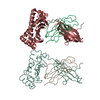 1nanC 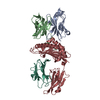 1fo0S S: Starting model for refinement C: citing same article ( |
|---|---|
| Similar structure data |
- Links
Links
- Assembly
Assembly
| Deposited unit | 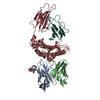
| ||||||||
|---|---|---|---|---|---|---|---|---|---|
| 1 |
| ||||||||
| Unit cell |
|
- Components
Components
-BM3.3 T Cell Receptor ... , 2 types, 2 molecules AB
| #1: Protein | Mass: 12945.639 Da / Num. of mol.: 1 / Fragment: Fv Fragment, Variable Domain Source method: isolated from a genetically manipulated source Source: (gene. exp.)   Mus musculus (house mouse) / Cell (production host): myeloma cells / Production host: Mus musculus (house mouse) / Cell (production host): myeloma cells / Production host:   Mus musculus (house mouse) / References: UniProt: Q5R1F1*PLUS Mus musculus (house mouse) / References: UniProt: Q5R1F1*PLUS |
|---|---|
| #2: Protein | Mass: 13064.964 Da / Num. of mol.: 1 / Fragment: Fv Fragment, Variable Domain Source method: isolated from a genetically manipulated source Source: (gene. exp.)   Mus musculus (house mouse) / Cell (production host): myeloma cells / Production host: Mus musculus (house mouse) / Cell (production host): myeloma cells / Production host:   Mus musculus (house mouse) / References: UniProt: P04214*PLUS Mus musculus (house mouse) / References: UniProt: P04214*PLUS |
-Protein , 2 types, 2 molecules HL
| #3: Protein | Mass: 31777.438 Da / Num. of mol.: 1 / Fragment: Extracellular Domains (alpha1, alpha2, alpha3) Source method: isolated from a genetically manipulated source Source: (gene. exp.)   Mus musculus (house mouse) / Gene: H2-K / Production host: Mus musculus (house mouse) / Gene: H2-K / Production host:   Escherichia coli (E. coli) / References: UniProt: P01901 Escherichia coli (E. coli) / References: UniProt: P01901 |
|---|---|
| #5: Protein |  Beta-2 microglobulin Beta-2 microglobulinMass: 11835.555 Da / Num. of mol.: 1 Source method: isolated from a genetically manipulated source Source: (gene. exp.)   Mus musculus (house mouse) / Gene: B2M / Production host: Mus musculus (house mouse) / Gene: B2M / Production host:   Escherichia coli (E. coli) / References: UniProt: P01887 Escherichia coli (E. coli) / References: UniProt: P01887 |
-Protein/peptide / Sugars / Non-polymers , 3 types, 103 molecules P

| #4: Protein/peptide |  Capsid / Nucleoprotein Capsid / NucleoproteinMass: 956.078 Da / Num. of mol.: 1 Fragment: Vesicular Stomatitis Virus Nucleoprotein fragment, residues (52-59) Source method: obtained synthetically Details: The 8-residue peptide of vesicular stomatitis virus was chemically synthesized. References: UniProt: P11212 |
|---|---|
| #6: Polysaccharide | 2-acetamido-2-deoxy-beta-D-glucopyranose-(1-4)-2-acetamido-2-deoxy-beta-D-glucopyranose / Mass: 424.401 Da / Num. of mol.: 1 / Mass: 424.401 Da / Num. of mol.: 1Source method: isolated from a genetically manipulated source |
| #7: Water | ChemComp-HOH /  Water Water |
-Experimental details
-Experiment
| Experiment | Method:  X-RAY DIFFRACTION / Number of used crystals: 1 X-RAY DIFFRACTION / Number of used crystals: 1 |
|---|
- Sample preparation
Sample preparation
| Crystal | Density Matthews: 3.66 Å3/Da / Density % sol: 66.17 % | ||||||||||||||||||||||||||||||||||||||||||
|---|---|---|---|---|---|---|---|---|---|---|---|---|---|---|---|---|---|---|---|---|---|---|---|---|---|---|---|---|---|---|---|---|---|---|---|---|---|---|---|---|---|---|---|
Crystal grow | Temperature: 277 K / Method: vapor diffusion, hanging drop Details: PEG6000 13-17%, MgAc 0.1M, NaCl 0-0.1M, Hepes 0.1M, pH 7.0 to 7.5, VAPOR DIFFUSION, HANGING DROP, temperature 277K | ||||||||||||||||||||||||||||||||||||||||||
| Crystal grow | *PLUS PH range low: 7.5 / PH range high: 7 | ||||||||||||||||||||||||||||||||||||||||||
| Components of the solutions | *PLUS
|
-Data collection
| Diffraction | Mean temperature: 100 K |
|---|---|
| Diffraction source | Source:  SYNCHROTRON / Site: SYNCHROTRON / Site:  ESRF ESRF  / Beamline: ID14-4 / Wavelength: 0.98 Å / Beamline: ID14-4 / Wavelength: 0.98 Å |
| Detector | Type: ADSC QUANTUM 4 / Detector: CCD / Date: Oct 6, 2002 |
| Radiation | Protocol: SINGLE WAVELENGTH / Monochromatic (M) / Laue (L): M / Scattering type: x-ray |
| Radiation wavelength | Wavelength : 0.98 Å / Relative weight: 1 : 0.98 Å / Relative weight: 1 |
| Reflection | Resolution: 2.7→35.1 Å / Num. all: 29887 / Num. obs: 29887 / % possible obs: 99.5 % / Observed criterion σ(F): 0 / Observed criterion σ(I): 0 / Redundancy: 3.8 % / Biso Wilson estimate: 60.2 Å2 / Rsym value: 0.083 / Net I/σ(I): 7.9 |
| Reflection shell | Resolution: 2.7→2.77 Å / Redundancy: 3.5 % / Mean I/σ(I) obs: 1.6 / Num. unique all: 2033 / Rsym value: 0.437 / % possible all: 99.2 |
| Reflection | *PLUS Rmerge(I) obs: 0.083 |
| Reflection shell | *PLUS % possible obs: 99.2 % / Rmerge(I) obs: 0.437 |
- Processing
Processing
| Software |
| |||||||||||||||||||||||||
|---|---|---|---|---|---|---|---|---|---|---|---|---|---|---|---|---|---|---|---|---|---|---|---|---|---|---|
| Refinement | Method to determine structure : :  MOLECULAR REPLACEMENT MOLECULAR REPLACEMENTStarting model: PDB ENTRY 1FO0 Resolution: 2.7→12 Å / Isotropic thermal model: ISOTROPIC / Cross valid method: THROUGHOUT / σ(F): 0 / Stereochemistry target values: Engh & Huber
| |||||||||||||||||||||||||
| Displacement parameters | Biso mean: 56.81 Å2
| |||||||||||||||||||||||||
| Refinement step | Cycle: LAST / Resolution: 2.7→12 Å
| |||||||||||||||||||||||||
| Refine LS restraints |
| |||||||||||||||||||||||||
| LS refinement shell | Resolution: 2.7→2.79 Å
| |||||||||||||||||||||||||
| Refinement | *PLUS Rfactor obs: 0.237 / Rfactor Rfree : 0.297 / Rfactor Rwork : 0.297 / Rfactor Rwork : 0.23 : 0.23 | |||||||||||||||||||||||||
| Solvent computation | *PLUS | |||||||||||||||||||||||||
| Displacement parameters | *PLUS | |||||||||||||||||||||||||
| Refine LS restraints | *PLUS
|
 Movie
Movie Controller
Controller



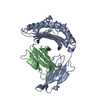




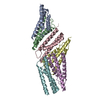

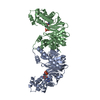

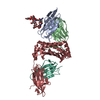
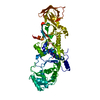
 PDBj
PDBj









